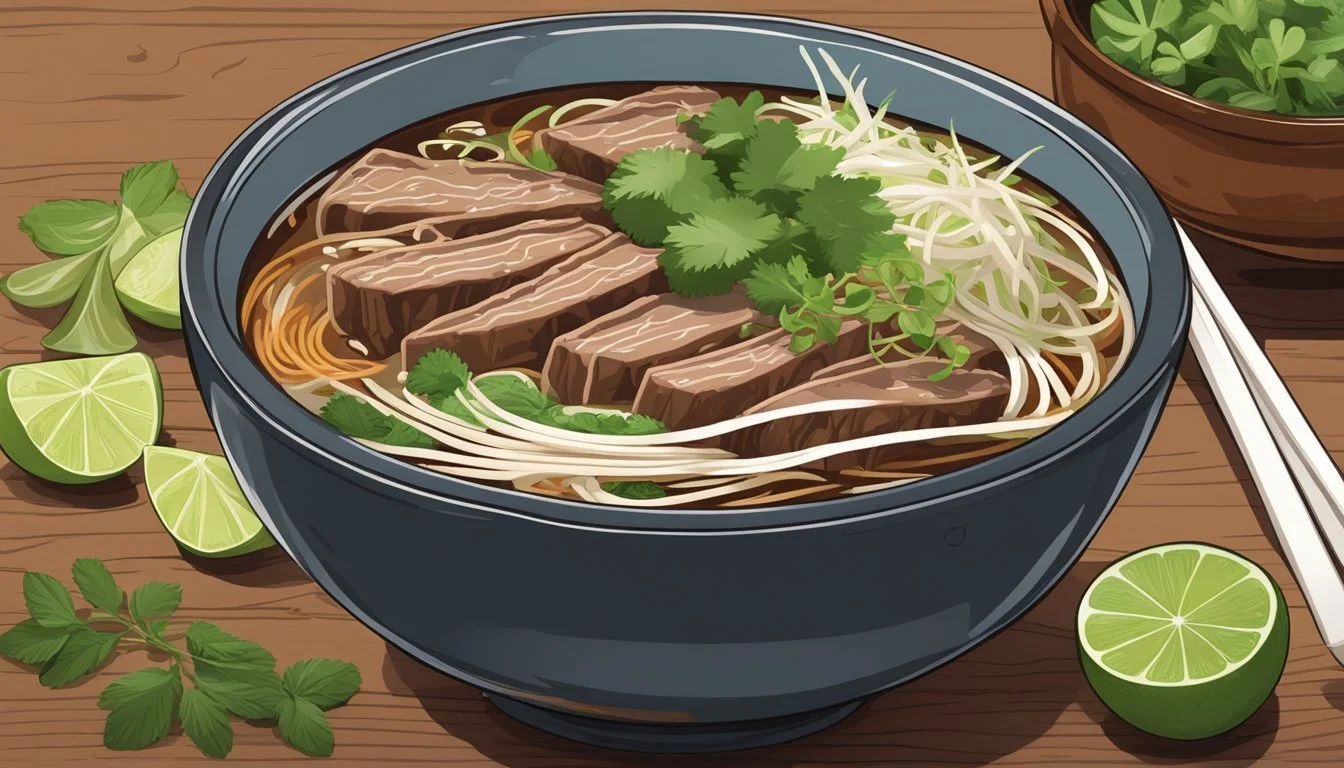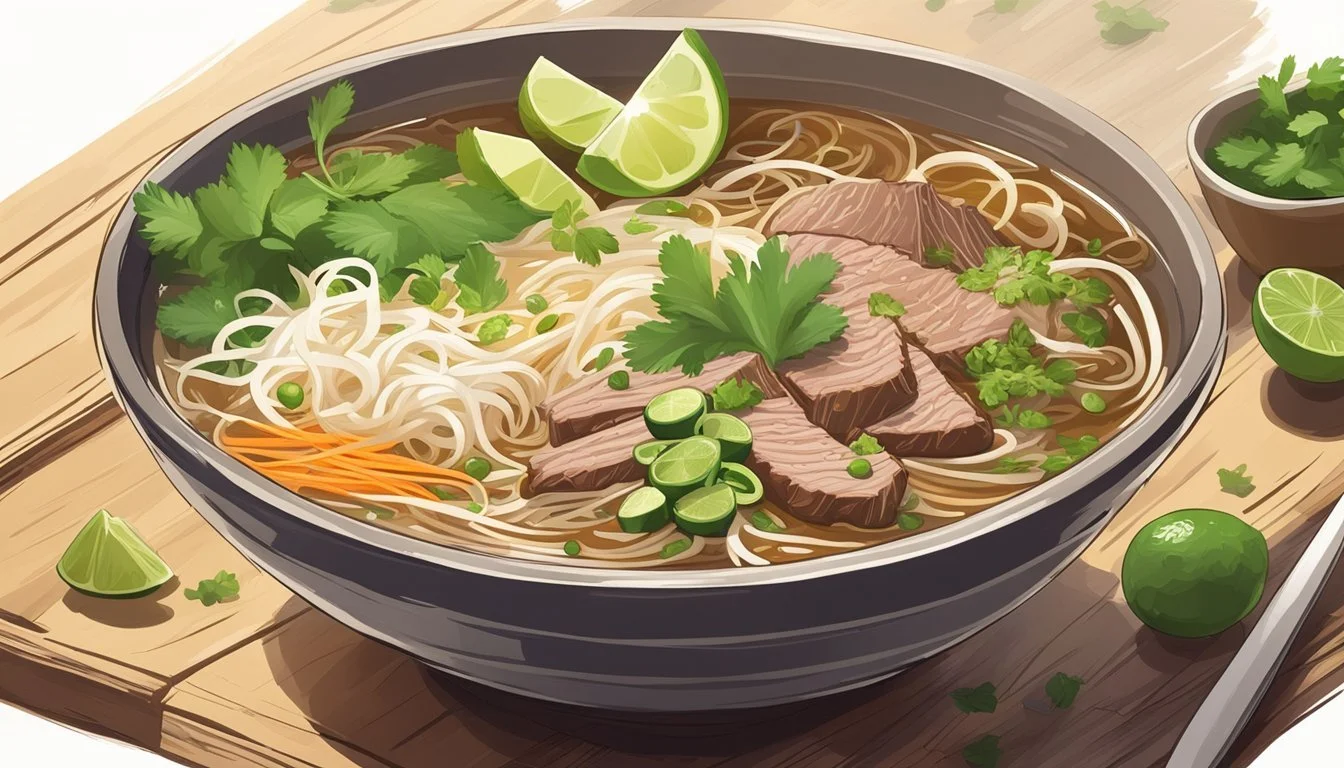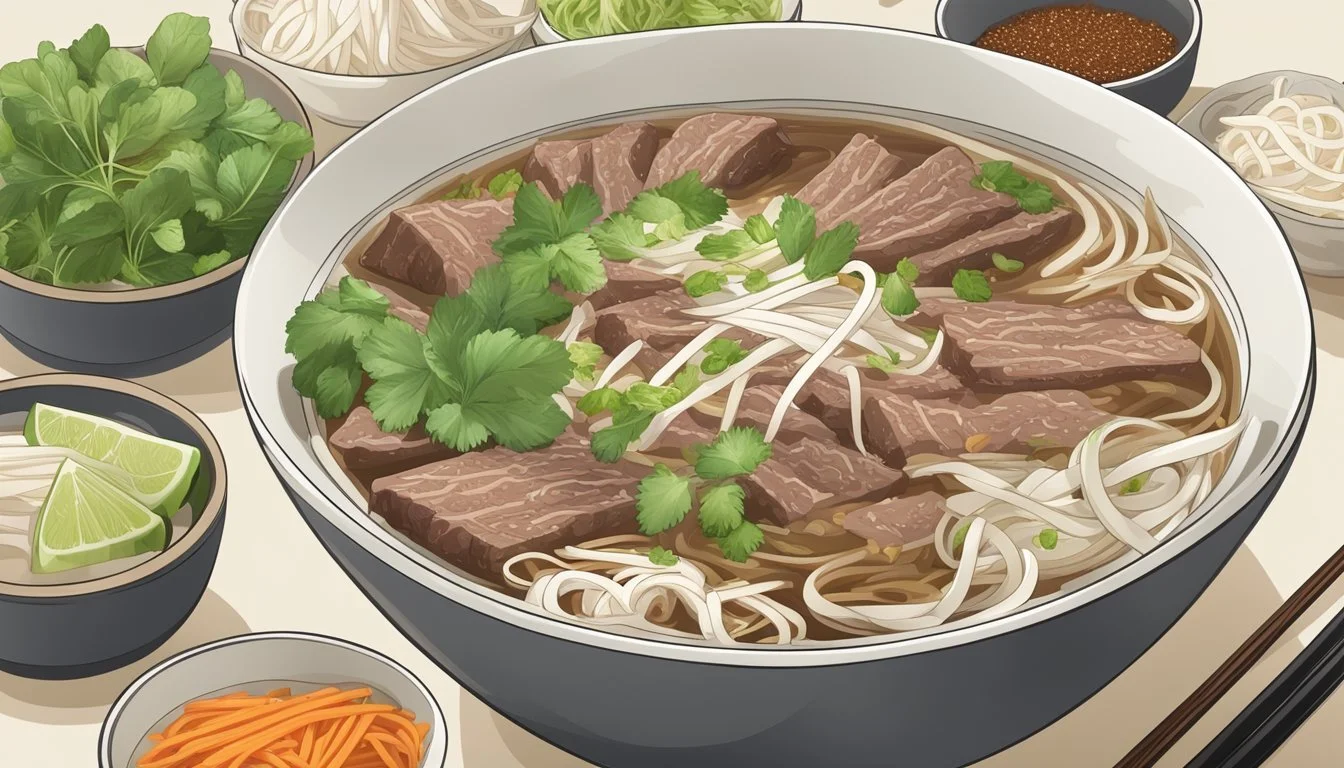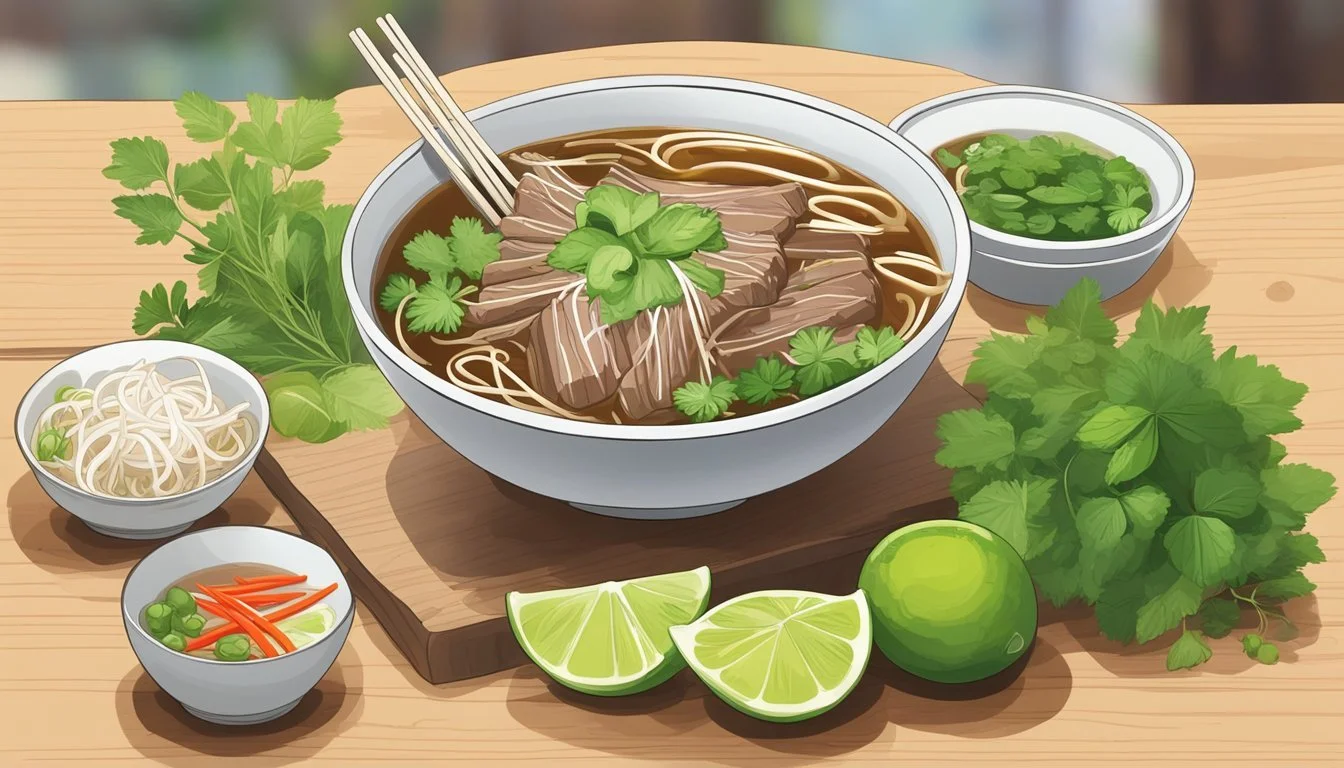Is Beef Pho Gluten-Free?
Unveiling the Truth About This Vietnamese Soup
Beef (What wine goes well with beef?) Pho, a Vietnamese culinary staple, is a comforting soup traditionally comprising a rich broth, rice noodles, thin slices of beef, and assorted herbs. Enthusiasts of this flavorful dish often inquire about its compatibility with gluten-free diets, particularly important for individuals with celiac disease or gluten sensitivity. Given the alarming effects of gluten ingestion for these groups, it is crucial to ascertain the gluten status of all meal components.
The fundamental ingredients of Beef Pho are generally gluten-free. The broth is typically made from simmered beef bones, while the noodles, known as bánh phở, are crafted from rice flour. This combination is inherently devoid of gluten, making it suitable for those avoiding this group of proteins. However, the assurance of a gluten-free meal necessitates a cautious examination of additional ingredients, such as sauces and the process of broth preparation, where sources of gluten may inadvertently be introduced.
What Is Pho?
Pho is a Vietnamese soup known for its flavorful broth, rice noodles, and a choice of meats. It is a beloved dish enjoyed worldwide, with roots in Vietnamese culture and cuisine.
History of Pho
Pho originated in northern Vietnam during the early 20th century. Northern Vietnamese Pho is typically known for its clear and simple broth, while Southern Vietnamese Pho is often richer, with a variety of additional herbs and garnishes. The dish spread to the rest of Vietnam and eventually across the world during the 20th century, especially after the Vietnam War, becoming a culinary emblem of Vietnamese cuisine.
Components of Pho
The fundamental components of Pho consist of:
Broth: A rich and aromatic stock usually made from simmering beef or chicken bones with spices such as star anise, cinnamon, cloves, cardamom, and coriander.
Rice Noodles (Bánh Phở): Flat white noodles made from rice flour and water, providing a gluten-free starch base.
Meats: Typically thin slices of beef (phở bò) or chicken (phở gà).
Herbs and Garnishes: Often includes fresh herbs like basil and cilantro, bean sprouts, lime wedges, and sliced chilies.
Variations of Pho
While beef and chicken are the traditional proteins found in Pho, there are various iterations, including:
Beef Pho (Phở Bò): The most popular version featuring various cuts of beef.
Chicken Pho (Phở Gà): A lighter alternative made with chicken.
Seafood Pho: Incorporating seafood instead of the traditional meats.
Vegetarian Pho (Phở Chay): Utilizing tofu and a variety of mushrooms.
Each variation maintains the essential elements of broth, rice noodles, and a harmonious blend of spices, while inviting creative interpretations with the range of available toppings and sides.
Understanding Gluten
When exploring the gluten content in foods like beef pho, it's essential to first understand what gluten is and how it affects certain individuals. Gluten is a group of proteins commonly found in grains such as wheat, barley, and rye. People with celiac disease or gluten sensitivity need to avoid gluten to maintain their health.
What Contains Gluten?
Grains containing gluten include:
Wheat: The most prevalent grain containing gluten, used in a variety of foods.
Barley: Often found in malt products, beer, and certain food colorings.
Rye: Less common than wheat but used in rye bread, rye beer, and some cereals.
Besides these grains, gluten is present in many processed foods for its binding and texture-enhancing properties. This makes checking labels an important habit for individuals avoiding gluten.
Gluten Sensitivity and Celiac Disease
Gluten sensitivity and celiac disease affect how one's body reacts to gluten:
Celiac Disease: An autoimmune disorder where ingestion of gluten leads to damage in the small intestine. It affects about 1% of the population.
Gluten Sensitivity: Also known as non-celiac gluten sensitivity (NCGS), it entails discomfort after consuming gluten, without the intestinal damage seen in celiac disease.
Diagnosis for either condition typically involves a combination of blood tests, genetic testing, and an intestinal biopsy for celiac disease or an assessment of symptoms improvement on a gluten-free diet for gluten sensitivity. Rice, the main ingredient in traditional pho noodles, is naturally gluten-free, making it a suitable option for those with gluten-related disorders. However, cross-contamination or the inclusion of sauces containing gluten can present risks.
Ingredients in Pho
Pho, a Vietnamese soup, traditionally includes a base of rice noodles, a hearty broth, and a selection of meats and herbs. Specific ingredients contribute to its distinctive flavor profile and, when prepared authentically, can be gluten-free.
The Role of Rice Noodles
Pho typically involves rice noodles (bánh phở), which are inherently gluten-free, as they are made from rice flour and water. Essential for the dish's structure, they should be cooked until tender, strained, and rinsed with cold water to halt the cooking process.
Traditional Pho Broth
The soul of pho lies in its broth, a complex concoction that demands patience to prepare. Key components include:
Beef bones: for richness and depth
Onions and ginger: charred to unearth a smoky essence
Spices: such as star anise, cloves, and cinnamon, which are paramount for the signature aroma
A slow simmering process extracts flavors from these ingredients, culminating in a broth that stands as the backbone of the dish.
Seasonings and Add-Ins
While the broth and rice noodles form the base, additional elements are crucial for the final taste. Various proteins can be used, with thin slices of beef being most common. Fresh herbs, including cilantro and basil, contribute a burst of green and a herbal top note.
For flavoring, fish sauce is a staple, lending the dish its umami quality. Care must be taken with sauces like soy sauce, as it generally contains gluten unless specified as gluten-free. It's imperative to verify all sauces and seasonings to ensure they do not contain gluten for a truly gluten-free pho.
Preparing Gluten-Free Beef Pho
When making gluten-free beef pho, attention to detail is crucial in selecting ingredients and preparing the broth to ensure the dish is safe for individuals with gluten sensitivities.
Choosing the Right Ingredients
To prepare gluten-free beef pho, it's essential to start with the correct foundation:
Rice Noodles: Always opt for 100% rice noodles, and avoid cross-contamination by cooking them in clean water.
Beef: Choose quality cuts of beef, such as flank, brisket, or sirloin, often used in traditional beef pho recipes.
Fresh Herbs: Common herbs include cilantro, basil, and green onions. Ensure they are fresh and not processed with any gluten-containing additives.
Gluten-Free Broth Considerations
The broth is the soul of pho, and special care is needed to guarantee its gluten-free status:
Beef Broth: Homemade beef broth or bone broth is ideal. If store-bought, verify it's labeled gluten-free.
Spices: Toast spices like cinnamon, star anise, cloves, and cardamom to enhance flavor naturally without gluten.
Fish Sauce: This is a common ingredient that may contain gluten, so search for a certified gluten-free option.
Alternative Gluten-Free Add-Ins
Enhance the flavor profile of your gluten-free beef pho with these add-ins:
Veggies: Mung bean sprouts, sliced onions, and Thai basil can add crunch and freshness.
Lime: A squeeze of lime juice accents the rich flavors of the broth and spices.
Chili: For a spicy kick, add slices of fresh chili pepper or a dollop of gluten-free chili sauce.
By carefully selecting ingredients and preparing each component with gluten-free guidelines in mind, chefs and home cooks can create a delicious and safe beef pho experience for everyone to enjoy.
Cross-Contamination Risks
When discussing beef Pho's gluten-free status, one must consider the potential for cross-contamination in both kitchen environments and during the dining out experience. This risk arises when gluten-containing ingredients or foods come into contact with gluten-free dishes during preparation or serving.
Kitchen Best Practices
In a kitchen setting, strict protocols are necessary to ensure a gluten-free meal remains safe from gluten exposure. It involves:
Using separate utensils and cookware reserved solely for gluten-free cooking.
Thoroughly cleaning surfaces and equipment prior to use, including slicers and cutting boards.
Clearly labeling gluten-free ingredients and storage areas to prevent mix-ups.
Dining Out Safely
When eating out, diners with gluten sensitivity must be vigilant to avoid cross-contamination. They should:
Communicate clearly with restaurant staff about their gluten sensitivities.
Choose restaurants with a reputation for handling gluten-free orders carefully.
Verify that the restaurant implements cross-contamination safety measures, such as:
Dedicated gluten-free preparation areas.
Separate cooking utensils and equipment for gluten-free dishes.
Staff trained in managing gluten-free orders and preventing cross-contamination.
Gluten-Free Pho Toppings and Condiments
When personalizing a bowl of beef pho with toppings and condiments, it is important for those needing a gluten-free diet to select items that do not contain or come into contact with gluten-containing ingredients.
Safe Topping Choices
Certain toppings are inherently gluten-free and add both flavor and nutrition to beef pho:
Basil: Adds a fresh, anise-like flavor to the dish.
Cilantro: Provides a citrusy and slightly peppery note.
Bean Sprouts: Offer a crunch and subtle sweetness.
Scallions: Give a mild oniony zest.
Jalapeño Pepper: Delivers heat and a green, crisp flavor.
Lime Wedges: A squeeze of lime brings acidity that can brighten the beef broth.
Here is an organized list of gluten-free toppings:
Toppings Description Basil Fresh herb with a hint of anise. Cilantro A bright, citrusy herbal addition. Bean Sprouts Adds sweetness and crunch. Scallions Provides onion-like zest without overpowering. Jalapeño Pepper Offers spice to those who prefer heat. Lime Wedges For a splash of acidity to enhance other flavors.
Condiments to Avoid or Verify
Certain condiments may contain gluten, so it’s essential for individuals with celiac disease or gluten sensitivity to avoid them or ensure they are gluten-free:
Hoisin Sauce: Often contains wheat; always check the label or verify with the restaurant.
Sriracha: Typically gluten-free, but it's important to check for a gluten-free label to be sure as formulations can vary.
Sauces: Even if they're not thickened with flour, some sauces may have hidden gluten due to additives or cross-contamination during manufacturing.
It is advisable for diners to inquire about the specific ingredients and preparation of condiments when dining out to stay within the bounds of their dietary restrictions.
Navigating Restaurant Menus
When one with celiac disease or gluten sensitivity is seeking to enjoy beef pho at a restaurant, careful menu examination is paramount. Beef pho, a traditional Vietnamese dish, primarily consists of broth, rice noodles, beef slices, and herbs. Though this dish may appear to be gluten-free at first glance, hidden gluten sources could be present.
Steps for Navigating Restaurant Menus:
Ask for a Gluten-Free Menu: Some restaurants provide a gluten-free menu upon request. This menu will list options devoid of gluten-containing ingredients.
Inquire About Broth Preparation: The restaurant’s beef stock used in pho broth could potentially contain gluten. Patrons should inquire whether the broth is made in-house or if it's a commercial product, which might include gluten as a stabilizer or flavoring.
Check on Sauces: Many Vietnamese sauces, including hoisin or soy sauce, can contain gluten. It's advisable to ensure condiments added to the beef pho are certified gluten-free.
Ensure Separate Cooking Area: Cross-contamination is a concern in kitchens that handle gluten-containing dishes. Customers should verify if the restaurant takes measures to prevent cross-contamination, such as using separate utensils and cooking spaces for gluten-free meals.
Helpful Tips:
Communication is Key: Clearly communicating dietary restrictions to the server can help them assist with selecting safe dishes.
Patronize Certified Restaurants: Some restaurants are certified gluten-free and will have a more rigorous approach to preventing cross-contact.
It's essential for diners to remember that while the core ingredients of beef pho are usually safe, they must remain vigilant about the preparation methods and condiments used at the restaurant to maintain a gluten-free diet.
Health and Nutritional Considerations
Beef pho is not only a flavorful dish but also carries health and nutritional benefits. This section explores the advantages of incorporating beef pho in a balanced diet and provides a breakdown of its nutritional composition.
Benefits of Beef Pho
Beef pho, a traditional Vietnamese soup, is typically rich in protein due to its beef content. This protein is essential for muscle repair and growth. Additionally, the soup contains a variety of fresh vegetables, such as onions, bean sprouts, and herbs, which contribute vitamins and minerals essential for good health. The broth itself, if made traditionally, may have a lower sodium content than processed or canned soups (What wine goes well with soups?), making it a healthier alternative for those monitoring their salt intake.
Understanding Nutritional Content
A bowl of beef pho can be considered a complete meal, providing not only protein but also a moderate amount of calories. Due to the presence of rice noodles, beef pho offers a source of carbohydrates, which the body uses for energy. However, when considering nutritional value, one must be aware that variations in recipes and portion sizes can significantly alter the nutritional profile. Here is a general breakdown of the nutritional content in a standard bowl of beef pho:
Nutrient Approximate Amount Calories 350-450 Protein 20-30g Carbohydrates 40-50g Sodium 1,000-1,500mg Dietary Fiber 2-3g Vitamins/Minerals Varied
It is important for individuals to inquire about the specific ingredients and preparation methods at restaurants to ensure they meet their dietary needs, especially when considering gluten content and the possibility of higher sodium levels due to added sauces.
Recipe Variations and Personalization
When personalizing Beef Pho, individuals can tailor the recipe to specific dietary preferences or desired spice levels. Substitutions with various proteins or a complete shift to plant-based ingredients are both popular options.
Vegetarian and Vegan options
For a vegetarian or vegan variant of Pho, one can substitute the beef with tofu or a variety of mushrooms for a savory umami flavor. These alternatives can be complemented with a robust vegetable broth to maintain the soup's richness. A vegan broth often includes ingredients such as:
Star anise
Cinnamon sticks
Cloves
Cardamom
Coriander seeds
These spices can be simmered with charred ginger and onions to achieve a depth of flavor similar to traditional Pho.
Adjusting Spices and Protein Choices
The traditional beef in Pho can easily be replaced with other proteins such as chicken, shrimp, or even steak. Each protein choice can harmonize with the season's fresh herbs and spices, allowing for a personalized touch to the dish. Adjustments to spice levels can be made with additional:
Jalapeños (for heat)
Fresh herbs (for aroma)
Lime (for acidity)
Regular taste tests during preparation allow for real-time seasoning and ensures the Pho meets personal taste preferences.
Conclusion
Beef Pho, a traditional Vietnamese noodle soup, typically contains ingredients that are naturally gluten-free. Rice noodles, used in Pho, are inherently free from gluten as they are made from rice flour. The main concern for gluten comes from additives, sauces, or cross-contamination during preparation.
When dining out or purchasing pre-made beef Pho, diners with celiac disease or gluten sensitivity should verify that the broth and sauces have not been exposed to gluten-containing ingredients. Many Pho restaurants understand the necessity of providing gluten-free options and may offer suitable versions of this meal.
Home-cooked beef Pho presents an opportunity for individuals to control the ingredients, ensuring the exclusion of gluten. Fresh herbs, unmarinated beef, and pure rice noodles contribute to a safe, gluten-free meal. However, caution is needed with spices and condiments, as they can sometimes contain hidden gluten.
In summary, beef Pho can be a gluten-free option, provided that:
The rice noodles are pure and not cross-contaminated.
The beef is not marinated in any sauce containing gluten.
The broth is made from scratch using gluten-free ingredients, or it is verified to be gluten-free.
Condiments and additional toppings are confirmed to be without gluten.
Given these considerations, beef Pho remains a delicious and often suitable choice for a gluten-free diet. It offers a combination of rich flavors and nutritional value, making it a favored option for many adhering to specific dietary requirements.








